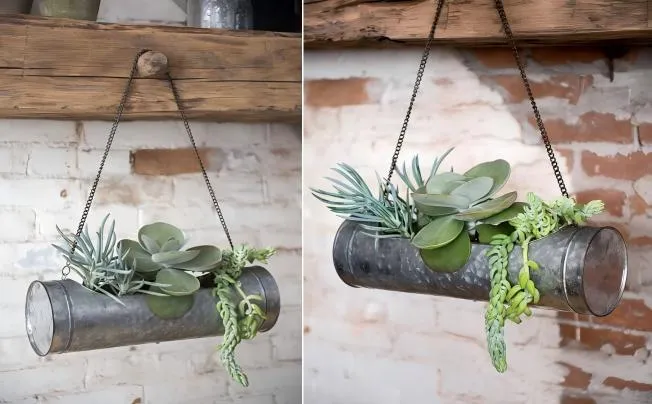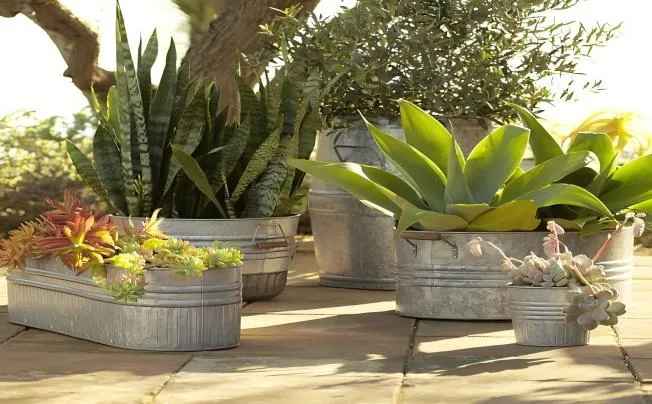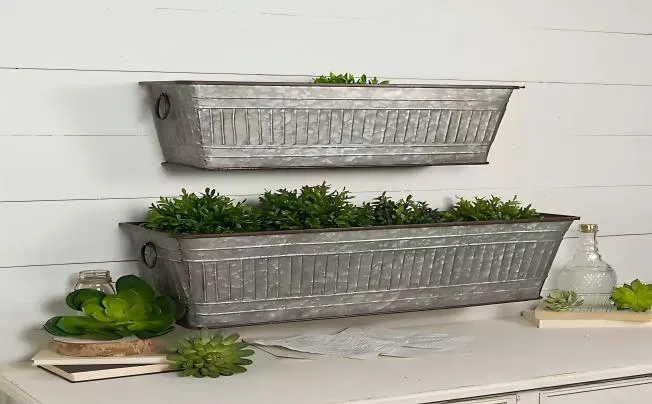Are Galvanized Planters Any Good?
Selecting the appropriate flower pot is essential when it comes to gardening decoration. It significantly influences the overall landscape effect in addition to the plant growing environment.
What are galvanized planters?
Galvanised steel is the primary component of galvanised flower pots. Because of its great strength, steel is difficult to distort or break, giving flower pots good stability and the ability to support a specific weight of soil and plants. There is no need to be concerned about the flower pots shattering under the weight of the plants, even if they are enormous.
The flower pots' resistance to rust is significantly increased by the exterior galvanised covering. By reacting with atmospheric oxygen to create a thick layer of zinc oxide, zinc may effectively stop oxygen and moisture from coming into touch with steel, slowing down the pace of rusting. Galvanised flower pots can withstand rust for a long time, increasing their useful life, even if they are left outside for an extended period of time and exposed to wind, sun, and rain.
In order to satisfy people's varied aesthetic preferences, this flower pot material may also be produced into a variety of shapes and styles using a variety of processing procedures. Galvanised flower pots can effortlessly accomplish any design, be it sleek and classic or sleek and futuristic.

Advantages of galvanized flower pots
1. Outstanding robustness
The zinc coating will react with the steel of the flower pot first when oxygen and moisture attempt to erode it. In order to successfully stop the chemical reaction that causes steel to rust, zinc will rapidly produce a thick layer of zinc oxide in the air, obstructing oxygen and moisture outside.
Galvanised flower pots can remain in good shape even in some tough settings. When exposed to prolonged light, plastic flower pots can age and become brittle, while wooden flower pots are more likely to rot and become wet than flower pots made of other materials. Because of its exceptional resistance to rust, galvanised flower pots have a far longer lifespan and are less expensive and troublesome to replace on a regular basis.
2. Unique appearance style
Galvanized flower pots have a simple yet stylish industrial style appearance. This style is very versatile and can be perfectly integrated with various decorative styles. In modern minimalist gardens, galvanized flower pots can be matched with plants with simple lines, such as cacti, succulents, etc., to create a simple and stylish atmosphere. In the European classical style courtyard, it might reverberate with fine statues and gorgeous fountains, revealing a noble and elegant disposition. Even in the little garden of pastoral style, galvanized flower pots can set off each other with flowers and plants full of natural breath, generating a distinct contrast beauty. Galvanized flower pots may satisfy your unique garden landscaping needs, regardless of your preference for traditional designs or the latest fashion trends.
3. Good stability
The galvanised flower pot itself has a certain weight because it is made of galvanised steel, which gives it good stability when put. It is difficult to be blown down or moved by the wind, regardless of whether it is positioned on either side of the garden walk or in an open area like a balcony or terrace.
Certain lighter ceramic or plastic flower pots may be blown over by strong winds, which could endanger the safety of nearby items and persons in addition to damaging the flower pots. With its inherent weight advantage, the galvanised flower pot can be securely anchored, giving plants a solid and secure growing environment.

Disadvantages of galvanized flower pots
1. Potential issue with zinc leaks
The zinc coating of the galvanised flower pot may partially disintegrate in some soil types, such as extremely acidic soil, which could result in zinc leaks. Even while plants require a certain quantity of zinc to flourish, too much zinc might harm them. According to studies, an excessively high zinc concentration in the soil might prevent plants from absorbing other minerals like iron, manganese, copper, etc., which can disrupt a plant's ability to grow and develop normally. Additionally, symptoms like chlorosis and yellowing of plant leaves may be brought on by an excess of zinc. In extreme situations, it might potentially impair plant development by interfering with photosynthesis and respiration.
However, the amount of zinc that seeps from galvanised flower pots often does not cause significant harm to plants under normal conditions, provided that they are not exposed to harsh soil conditions for an extended period of time. However, while using galvanised flower pots, additional attention must be paid to monitoring the pH and zinc concentration of the soil for certain plant kinds that are very sensitive to zinc.
2. Limited possibilities for appearance
Even while many people like the industrial look of galvanized flower pots, there aren't as many colour and form design alternatives as there are for flower pots made of other materials, including ceramic or plastic. By adding different pigments, plastic flower pots can be transformed into a wide range of vibrant colours. They can also be readily moulded into a variety of odd and adorable shapes to satisfy the needs of different customers for fun and personalization. With their rich and varied colour glazes, beautiful pattern designs, and a variety of traditional and contemporary shapes, ceramic flower pots exhibit a certain kind of creative beauty.
Silver, grey, and black are common colours for galvanized flower pots, which are either based on fundamental metal colours or colours that have been simply spray-painted. While basic shapes like round, square, and rectangular are also available, they are somewhat lacking in terms of creativity and varied design. Galvanised flower pots might not be the best option if you want to create a colourful and varied garden landscape and strive for a rich and varied appearance.

Selected Blogs
-
What customization services are available for metalworking customization?
2024-12-12
-
What Is The Difference Between A Plant Container And A Raised Bed?
2024-04-23
-
Garden Screening & Fence Panels
2024-04-23
-
Gardening pot selection tips
2024-04-17
-
The function and collocation of horticultural fire pot
2024-04-17


